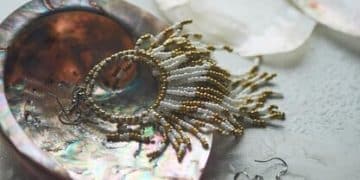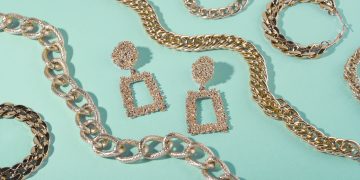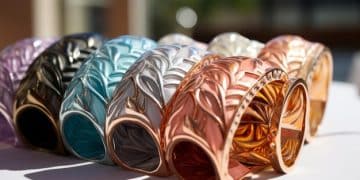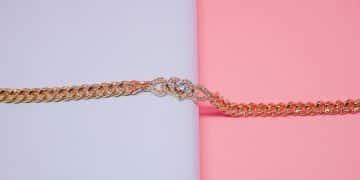Is Your Fashion Jewelry Hypoallergenic? A 2025 Guide

Navigating the complexities of hypoallergenic fashion jewelry is crucial in 2025, primarily due to the prevalent issue of nickel content and the increasing demand for safer, non-irritating alternatives that ensure comfort and style for sensitive skin without compromising aesthetic appeal.
In a world where personal expression often adorns our bodies, the allure of fashion jewelry is undeniable. Yet, for many, the beauty of a necklace or a pair of earrings can quickly turn into discomfort, itching, or even a painful rash. This common dilemma brings us to a crucial question for 2025: Is Your Fashion Jewelry Hypoallergenic? A 2025 Guide to Nickel Content and Alternatives.
Understanding Nickel Allergy and Its Impact
Nickel is a ubiquitous metal found in a surprisingly vast array of everyday items, extending far beyond the realm of jewelry. However, its presence in fashion jewelry is particularly problematic due to prolonged skin contact, which can trigger allergic reactions in susceptible individuals. This common allergy, known as allergic contact dermatitis, manifests as an uncomfortable rash.
The global prevalence of nickel allergy highlights it as a significant public health concern. Estimates suggest that between 10% and 20% of the general population may be allergic to nickel, with women showing a higher propensity. This disparity is often attributed to earlier and more frequent exposure to nickel-containing jewelry, particularly earrings, from a young age.
Recognizing the Symptoms of Nickel Allergy
Identifying a nickel allergy often involves observing specific skin reactions following contact with nickel-containing items. The symptoms can vary in severity but typically present in predictable ways:
- 🩹 Redness and inflammation around the contact area.
- 🫧 Itching, sometimes intense and persistent.
- 💧 Blisters or fluid-filled bumps, which may ooze or crust over.
- 🔥 Dry patches resembling eczema.
- ⚫ Darkening of the skin in chronic cases.
These symptoms usually appear within 12 to 48 hours after exposure and can persist for several weeks, even after the removal of the offending item. The key is to recognize the pattern and connect it to specific jewelry pieces.
The mechanism behind a nickel allergy is an immune system misfire. When nickel comes into contact with the skin, it can bind to proteins, forming a complex that the immune system mistakenly identifies as a threat. This triggers an inflammatory response. Once sensitized to nickel, even minimal exposure can elicit a reaction, making prevention paramount for those affected.
For individuals new to the world of fashion jewelry or those developing sudden sensitivities, understanding nickel allergy is the critical first step. It empowers consumers to make informed choices that prioritize both style and well-being, paving the way for a more comfortable and enjoyable jewelry experience.
The 2025 Landscape of Nickel Regulation in Fashion Jewelry
As consumer awareness of nickel allergies escalated, regulatory bodies worldwide began implementing directives to limit nickel release by products in direct and prolonged contact with the skin. While these regulations aim to protect consumers, their effectiveness and global consistency remain varied, especially regarding fashion jewelry.
The European Union (EU) has historically been at the forefront of nickel regulation, with its REACH (Registration, Evaluation, Authorisation and Restriction of Chemicals) regulation setting stringent limits. The primary focus of these regulations is the “nickel release rate,” which measures the amount of nickel released from an object over a period. This is considered a more accurate indicator of allergenic potential than simply measuring total nickel content.
Key Regulatory Standards and Their Limitations
The EU’s nickel directive specifies that jewelry items intended to come into direct and prolonged contact with the skin, such as earrings, necklaces, bracelets, and rings, should not release nickel at a rate exceeding 0.5 micrograms per square centimeter per week. For articles inserted into pierced ears or other body parts, an even stricter limit of 0.2 micrograms per square centimeter per week applies.
In the United States, regulations concerning nickel in jewelry are not as comprehensive or federally harmonized as in the EU. While some states, like California, have adopted their own, more restrictive laws, a consistent federal standard akin to the EU’s is absent. This disparity means that fashion jewelry imported into the US from countries without strict nickel regulations might still contain higher levels of releasable nickel, posing a risk to sensitive individuals.
The challenge for consumers in 2025 lies in the patchwork nature of these regulations. A piece marketed as “hypoallergenic” in one region might not meet the stricter standards of another. This highlights the importance of not solely relying on general labeling but understanding the underlying material composition and, where possible, inquiring about specific nickel release rates or testing.
As the market for fashion jewelry continues to globalize, consumers must remain vigilant. The absence of a universal “hypoallergenic” standard means that due diligence is key. Understanding the nuances of nickel regulation is vital for safeguarding skin health and ensuring that personal style does not come at the cost of comfort.
Decoding “Hypoallergenic”: What Does It Really Mean?
The term “hypoallergenic” is frequently used across various consumer products, from cosmetics to textiles and, crucially, jewelry. While it suggests a reduced likelihood of causing an allergic reaction, its legal and practical interpretation can be far from clear-cut, especially in the context of fashion jewelry.
Legally, “hypoallergenic” is not universally defined or regulated. Unlike the clear limits set for nickel release in the EU, in many other regions, including parts of the US, the term is self-regulated by manufacturers. This can lead to a broad spectrum of what “hypoallergenic” truly signifies: it might mean the item contains no nickel, or it might simply mean it contains a low enough nickel content to reduce the risk of a reaction for some individuals. It rarely guarantees a complete absence of all potential allergens.
Common Misconceptions and Lack of Standardization
Many consumers mistakenly believe that “hypoallergenic” jewelry is entirely free of all known allergens. This is a significant misconception. While nickel is the most common metal allergen in jewelry, other metals, such as cobalt or copper, can also provoke reactions in sensitive individuals, though less frequently. True hypoallergenic claims would need to address a broader range of potential irritants.
The lack of a standardized definition allows for a wide interpretation by manufacturers. Some brands might label items “hypoallergenic” if they are nickel-free, while others might consider a piece hypoallergenic if its nickel release rate falls below the EU’s stringent standards, even if it still contains trace amounts of nickel.
When purchasing fashion jewelry labeled “hypoallergenic” in 2025, consumers are advised to look beyond the label itself. Reputable brands often provide more detailed information about their materials, such as “nickel-free brass,” “surgical stainless steel,” or “titanium.” This transparency offers a more reliable indicator of true hypoallergenic properties than the often vague “hypoallergenic” claim alone.
Ultimately, “hypoallergenic” serves as a useful guiding term, indicating a conscious effort by the manufacturer to minimize allergenic potential. However, it requires an educated consumer to delve deeper into the material specifics to ensure the jewelry meets their individual sensitivity needs. This critical evaluation is what empowers informed choices in the evolving landscape of fashion jewelry.
Common “Hypoallergenic” Materials and Their Nickel Content
For those navigating the challenges of sensitive skin, knowing which materials are genuinely low in nickel or entirely nickel-free is paramount. While no metal is truly “allergy-proof” for everyone, certain materials are far less likely to cause a reaction due to their inherent properties or the way they are processed.
The primary concern regarding nickel in jewelry lies in its presence as an alloy. Nickel is often added to cheaper metals like brass, copper, or low-grade stainless steel to enhance their hardness, durability, or improve their color. This practice is where the problem arises for individuals with sensitivities.
Top Choices for Sensitive Skin in 2025
When seeking truly hypoallergenic fashion jewelry, several materials stand out for their low or absent nickel content:
- ✨ Surgical Stainless Steel: Often used in medical implants, this material (typically 316L grade) is known for its low nickel release rate, making it safe for most individuals, though it does contain nickel as part of its alloy structure. The nickel is tightly bound, preventing its release.
- 💫 Titanium: Highly biocompatible, titanium is completely nickel-free and exceptionally strong, lightweight, and resistant to corrosion. It’s an excellent choice for those with severe nickel allergies.
- ⚜️ Niobium: Similar to titanium, niobium is another inert and utterly nickel-free metal. It’s often used for body piercing jewelry due to its excellent healing properties and is exceptionally safe for sensitive skin.
- 🌟 Sterling Silver (925): While traditional sterling silver is 92.5% pure silver and 7.5% other metals (often copper), some formulations can contain trace amounts of nickel. For truly sensitive skin, look for “nickel-free sterling silver” or brands that explicitly state their alloys.
- 💛 High-Karat Gold (14K, 18K, 24K): Pure gold (24K) is naturally hypoallergenic. Lower karat golds (e.g., 14K or 18K) are alloys, and white gold, in particular, commonly uses nickel for its white color. Yellow gold is generally a safer bet, but always inquire about alloy compositions.
- 💡 Platinum: A noble metal, platinum is naturally hypoallergenic and highly resistant to tarnishing and corrosion. It is an excellent, but often more expensive, option for sensitive skin.
Beyond these metals, certain alternative materials are gaining traction in fashion jewelry for their hypoallergenic qualities. These include glass, wood, natural shells, and various types of high-quality plastics like acrylic or resin, provided they are not coated with nickel-containing finishes.
The material composition of the plating also plays a crucial role. Even if a base metal is hypoallergenic, a nickel-containing plating can still trigger a reaction. Opt for rhodium, gold, or silver plating when guaranteed to be nickel-free. Understanding these material specifics is the key to enjoying fashion jewelry without allergic reactions.
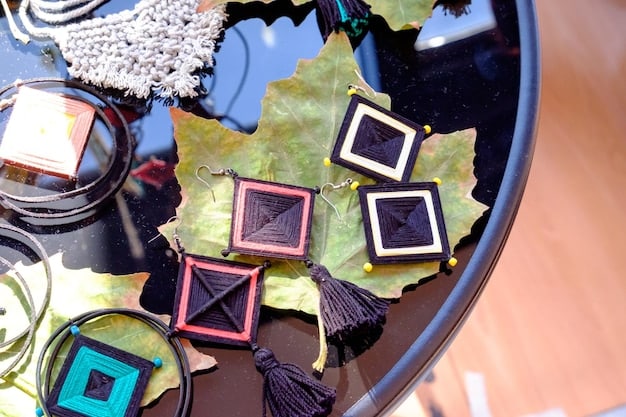
Practical Tips for Identifying Hypoallergenic Jewelry in Stores and Online
Navigating the vast market of fashion jewelry, whether in a bustling boutique or an endless online catalog, requires a keen eye and a strategic approach when seeking genuinely hypoallergenic pieces. While labels and descriptions can be helpful, knowing what to look for and what questions to ask is essential.
When shopping in physical stores, the first step is always to check the product labeling. Look for explicit mentions of “nickel-free,” “hypoallergenic,” “surgical stainless steel,” “titanium,” or “niobium.” These are the most reliable indicators. Don’t hesitate to ask sales associates for detailed information about the metal composition and any coatings used. Reputable jewelers should be able to provide this information readily.
Savvy Shopping Strategies for Sensitive Skin
For online shopping, which offers a broader selection but less tactile inspection, research becomes even more critical. Here are practical strategies for 2025:
- 🕵️ Read Product Descriptions Carefully: Look for specific material descriptions rather than relying solely on the term “hypoallergenic.” Verify details about the base metal and any plating materials.
- 💬 Check Customer Reviews: Past buyers often share their experiences, including whether the jewelry caused allergic reactions. This anecdotal evidence can be very insightful.
- 📜 Examine Return Policies: If a piece causes a reaction, a flexible return policy allows you to return it without hassle.
- 📩 Contact the Seller Directly: For unclear information, send a message to the seller or brand. Ask specific questions about nickel content and manufacturing processes.
- ✅ Look for Certifications (if available): While rare for fashion jewelry, some brands might offer certifications or conduct independent lab tests to verify their nickel-free claims.
Be wary of overly vague descriptions or those that simply state “alloy” without further specification. Cheaper jewelry often uses alloys that contain nickel to cut costs. Also, consider the color of the metal; white metals like rhodium or platinum are generally safer as plating than white gold, which often uses nickel in its alloy.
Finally, always perform a visual inspection. While it won’t reveal nickel content, it can give clues about the quality of the plating. Poorly plated items are more likely to wear off quickly, exposing the underlying problematic metal. By combining diligent research with careful inspection, sensitive individuals can confidently select fashion jewelry that is both stylish and safe.
Advanced Alternatives and Emerging Technologies in 2025
The demand for truly hypoallergenic jewelry, coupled with advancements in material science, is driving innovation in the fashion industry. Beyond traditional gold and titanium, 2025 is set to see a greater prominence of advanced alternatives and emerging technologies that promise both style and safety for sensitive skin.
One significant area of development is the refinement of existing materials. Manufacturers are increasingly focusing on producing higher grades of surgical stainless steel and experimenting with new passivation techniques to further reduce the nickel release from these alloys. This involves surface treatments that create an inert layer, preventing nickel ions from migrating to the skin.
Innovations for a Nickel-Free Future
Several cutting-edge materials and processes are emerging as viable alternatives:
- ⚙️ Medical-Grade Polymers: Beyond traditional plastics, new biocompatible polymers are being developed that offer exciting possibilities for lightweight, colorful, and completely nickel-free jewelry. These materials are often used in medical devices, underscoring their safety profile.
- ⚛️ Advanced Ceramic Composites: Ceramics, known for their hardness and inertness, are being combined with other materials to create durable and hypoallergenic jewelry pieces. These can offer unique aesthetic qualities, including a range of vibrant colors and finishes.
- 💡 PVD (Physical Vapor Deposition) Coatings: While plating is not new, PVD technology is becoming more sophisticated. This process applies a thin, durable, and often hypoallergenic coating (like titanium nitride or zirconium nitride) in a vacuum, creating a bond much stronger and more durable than traditional electroplating, significantly reducing the risk of underlying nickel exposure.
- 🌿 Sustainable and Natural Materials: There’s a growing trend towards natural and sustainable materials that are inherently hypoallergenic, such as innovative plant-based resins, responsibly sourced wood, and repurposed natural elements.
- 🔬 Bio-Metallic Alloys: Research continues into new metallic alloys specifically designed to be highly biocompatible, bypassing potential irritants found in traditional alloys. These are often developed in parallel with medical implant research, setting high safety standards.
The goal of these innovations is not just to be nickel-free but to offer a broader spectrum of textures, colors, and designs that push the boundaries of fashion jewelry without compromising on comfort. These advancements reflect a growing commitment within the industry to cater to the needs of all consumers, ensuring that sensitive skin doesn’t have to mean sacrificing personal style.
As 2025 unfolds, expect to see these advanced materials and technologies become more accessible and affordable, democratizing truly hypoallergenic fashion jewelry and allowing more individuals to embrace adornment worry-free.

Caring for Your Hypoallergenic Jewelry to Maintain Integrity
Acquiring truly hypoallergenic jewelry is a significant step towards comfortable adornment, but proper care is equally crucial to maintaining its integrity and ensuring its long-term hypoallergenic properties. Even the most inert metals can be compromised by improper handling or exposure to harsh chemicals.
The fundamental principle of caring for hypoallergenic jewelry revolves around minimizing exposure to substances that could degrade its surface or introduce irritants. This includes harsh cleaning agents, excessive moisture, and certain cosmetic products.
Best Practices for Longevity and Skin Safety
To ensure your hypoallergenic jewelry remains safe for your skin and beautiful for years to come, follow these essential care guidelines:
- 🚿 Avoid Chemical Exposure: Remove jewelry before applying lotions, perfumes, hairsprays, and before swimming in chlorinated pools or hot tubs. Chemicals can react with metals or degrade protective coatings, potentially exposing underlying, less hypoallergenic metals.
- 🧼 Clean Gently: Clean your jewelry regularly with mild soap (like clear dish soap) and warm water. Use a soft cloth or a very soft brush to gently remove oils and buildup. Rinse thoroughly and dry completely with a lint-free cloth.
- 🌬️ Ensure Thorough Drying: Moisture trapped in crevices can lead to corrosion over time, even with resistant metals. Always ensure jewelry is completely dry before storing it.
- 📦 Store Properly: Store each piece of jewelry separately in a soft pouch or a lined jewelry box to prevent scratching and exposure to air and humidity, which can accelerate tarnishing or degradation. Air-tight bags can also be beneficial for some metals.
- 🧤 Handle with Care: Oils and acids from your skin can accumulate on jewelry. Handle pieces by their edges or with clean hands to minimize transfer.
For plated hypoallergenic jewelry, such as pieces with a rhodium or gold plating over a nickel-free base, special attention is needed. While PVD coatings are durable, traditional platings can wear thin over time, especially in high-friction areas. Regular, gentle cleaning and avoiding abrasive materials will extend their life.
Observing changes in your jewelry’s appearance, such as discoloration or dullness, can be an early indicator that it requires cleaning or that a protective coating might be wearing off. By adopting these simple yet effective care routines, you can prolong the life and hypoallergenic qualities of your cherished fashion jewelry, ensuring comfortable and stylish wear for years to come.
| Key Point | Brief Description |
|---|---|
| 🩹 Nickel Allergy | Common skin irritation from nickel in jewelry, varying in severity. |
| ⚖️ Regulations | EU has strict nickel release limits; US regulations are less uniform. |
| ✨ Hypoallergenic | Indicates reduced allergen risk, but not standardized; check material specifics. |
| 🛠️ Safe Materials | Titanium, niobium, surgical stainless steel, pure gold/platinum are top choices. |
Frequently Asked Questions About Hypoallergenic Jewelry
▼
Nickel-free jewelry means the item contains no nickel or only trace amounts below the threshold for causing an allergic reaction. This is often the safest bet for highly sensitive individuals, as nickel is the most common metal allergen found in jewelry and everyday items. Always look for explicit “nickel-free” labeling, especially for items in prolonged skin contact.
▼
Yes, unlike some allergies present from birth, nickel allergy is a delayed-type hypersensitivity that develops after repeated or prolonged exposure to nickel. This means you can become sensitized at any point in your life, even if you’ve worn nickel-containing jewelry without issues before. Once sensitized, even minimal future exposure can trigger a reaction.
▼
Not all stainless steel is hypoallergenic. While surgical-grade stainless steel (like 316L) is generally considered hypoallergenic because its nickel is tightly bound and not easily released, other grades of stainless steel might release more nickel. It’s crucial to look for “surgical stainless steel” specifically rather than just “stainless steel” to ensure lower allergen risk.
▼
Dye-spot tests, such as those using dimethylglyoxime (DMG) solution, are available for home use. These kits involve applying a few drops of the solution to the jewelry surface. If the solution turns pink/red, it indicates the presence of releasable nickel. This method is effective for identifying items that could cause a reaction, although it may damage some finishes.
▼
While natural materials like wood, shell, or bone are generally considered safe as they inherently contain no metals like nickel, it’s essential to consider any finishes, dyes, or adhesives used in their crafting. Some lacquers or glues might contain allergens. Always ensure the entire piece, including findings and embellishments, is made without irritants.
Conclusion
The quest for stylish yet comfortable fashion jewelry often leads sensitive individuals down a complex path, fraught with concerns over nickel content and vague “hypoallergenic” claims. As we move through 2025, understanding the nuances of nickel allergy, the varying global regulations, and the true meaning behind material labels becomes less about preference and more about essential consumer literacy. The landscape is evolving, with innovation bringing new, safer materials and manufacturing techniques to the forefront. By prioritizing informed choices, embracing transparency, and committing to proper jewelry care, consumers no longer have to sacrifice personal style for comfort. The future of fashion jewelry is increasingly inclusive, offering elegant and diverse options that cater to all skin types, ensuring that beauty can be enjoyed universally and without compromise.
